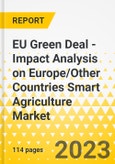According to this report, the EU Green Deal is set to have a substantial impact on the smart agriculture market in Europe and beyond
This report comes with 10% free customization, enabling you to add data that meets your specific business needs.
Market Introduction
The smart agriculture market is poised for significant growth, driven by the European Union Green Deal and global climate initiatives that emphasize the need for sustainable and resilient farming practices. By integrating advanced technologies such as precision farming, IoT, drones, and AI, smart agriculture enhances productivity and efficiency while minimizing environmental impact. This market is critical in supporting the EU's goals of reducing greenhouse gas emissions and reversing biodiversity loss. Smart agriculture not only optimizes resource use but also promotes climate resilience through water-efficient irrigation, improved livestock management, and the adoption of climate-resistant crops. It plays a vital role in addressing food and nutrition insecurity by improving yields and promoting sustainable farming practices. The increasing investment by entities such as the World Bank underscores the sector's importance in transforming the global agrifood system, aligning with climate goals, and fostering economic growth and rural development.Industrial Impact
The implementation of the EU Green Deal is set to impact the smart agriculture market significantly, driving substantial industrial growth and innovation. By prioritizing sustainability and climate resilience, the Green Deal creates a strong demand for advanced agricultural technologies, including precision farming, IoT, and AI. This shift toward sustainable practices accelerates the adoption of smart agriculture solutions that enhance productivity, reduce environmental impact, and improve resource efficiency. Industries involved in the development and deployment of these technologies are likely to experience increased investment and market expansion. Furthermore, the Green Deal's emphasis on reducing greenhouse gas emissions and promoting biodiversity positions smart agriculture as a key sector in achieving these goals. As a result, the market is expected to see heightened activity in research, development, and the implementation of climate-smart practices, driving both economic growth and the transition to a more sustainable agricultural industry across the globe.Countries Considered:
- U.S.
- Canada
- Mexico
- Brazil
- Chile
- Peru
- South Africa
- Saudi Arabia
- U.A.E.
- Egypt
- Turkey
- Israel
- South Korea
- Vietnam
- China
- Japan
- Singapore
- Australia
- New Zealand
Recent developments of the EU Green Deal:
- In January 2024, Trimble launched the Connected Climate Exchange, a groundbreaking carbon marketplace designed to support the European Union's Green Deal by advancing sustainability in the agriculture sector. This platform bridges the gap between farmers, agronomists, and businesses, facilitating the aggregation and verification of data across the agricultural supply chain. By integrating with existing farm management tools, Trimble ensures that sustainability efforts are both scalable and measurable, thereby contributing significantly to the EU's broader goals of achieving climate neutrality by 2050.
- In November 2023, the EU and Canada established a Green Alliance to strengthen cooperation on climate action, environmental protection, and green technology. This partnership will accelerate the adoption of climate-resilient practices, nature-based solutions, and innovative technologies in Canada, enhancing agricultural sustainability.
- In April 2023, the World Bank approved a $345 million loan to support China's Green Agricultural and Rural Revitalization Program, enhancing sustainability in Hubei and Hunan provinces, alongside a US$4.1 billion commitment from the Chinese government.
How can this report add value to an organization?
Innovation Strategy: This offers insights into various methods and practices that align with the EU Green Deal's sustainability objectives. By gaining a comprehensive understanding of the smart agriculture market and evaluating the challenges and opportunities presented by the EU Green Deal, stakeholders in the leading countries importing agricultural goods from the EU can assess the potential impact on their respective nations and organizations.Growth/Marketing Strategy: The smart agriculture market has witnessed significant advancements driven by key players through product launches, innovations, business expansions, and strategic collaborations. Companies are increasingly forming partnerships, collaborations, and joint ventures with major EU-based firms to meet EU standards, expand their operations, and reach a wider customer base. For instance, in April 2023, the Swiss company PLNTZ announced the cultivation of 15 hectares of EU-certified hemp varieties in Austria, aimed at extracting flowers, CBD, and other fibers.
Competitive Strategy: The report provides an analysis and profiling of key countries within the smart agriculture market that import agricultural products from the EU. Additionally, it thoroughly examines the challenges and opportunities in these countries, enabling readers to understand how market players compare, thereby presenting a clear view of the competitive landscape.
Research Methodology
Factors
- The scope of this report focuses on the EU Green Deal and its implementation in Europe and other countries’ smart agriculture markets.
- The base currency considered for the market analysis is US$. Currencies other than the US$ have been converted to the US$ for all statistical calculations, considering the average conversion rate for that particular year.
- The currency conversion rate has been taken from the historical exchange rate of the FxTop website.
- Nearly all the recent developments from January 2021 to August 2024 have been considered in this research study.
- The information rendered in the report is a result of in-depth primary interviews, surveys, and secondary analysis.
- Where relevant information was not available, proxy indicators and extrapolation were employed.
- Technologies currently used are expected to persist, with no major breakthroughs.
Secondary Research
This research study of the EU Green Deal involves extensive secondary research, directories, company websites, and annual reports. It also makes use of databases, such as ITU, Hoovers, Bloomberg, Businessweek, and Factiva, to collect useful and effective information for an extensive, technical, market-oriented study.Some of the prominent names in this market are:
- Bayer Crop Sciences
- Nestle S.A.
- Yara
- BASF SE
- Trimble Inc.
This product will be delivered within 3-5 business days.








